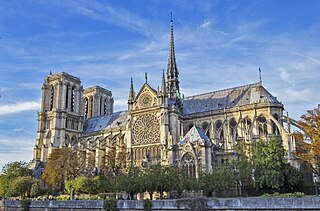
Notre-Dame de Paris, referred to simply as Notre-Dame, is a medieval Catholic cathedral on the Île de la Cité, in the 4th arrondissement of Paris, France. The cathedral, dedicated to the Virgin Mary, is considered one of the finest examples of French Gothic architecture. Several attributes set it apart from the earlier Romanesque style, particularly its pioneering use of the rib vault and flying buttress, its enormous and colourful rose windows, and the naturalism and abundance of its sculptural decoration. Notre-Dame also stands out for its three pipe organs and its immense church bells.

The Church of Sainte-Marie-Madeleine, or less formally, La Madeleine, is a Catholic parish church on Place de la Madeleine in the 8th arrondissement of Paris. It was planned by Louis XV as the focal point of the new Rue Royal, leading to the new Place Louis XV, the present Place de la Concorde. It was dedicated in 1764 by Louis XV, but work halted due to the French Revolution. Napoleon Bonaparte had it redesigned in the Neoclassical style to become a monument to the glory of his armies. After his downfall in 1814 construction as a church resumed, but it was not completed until 1842. The building is surrounded on all four sides by columns in the Corinthian style. The interior is noted for its frescoes on the domed ceiling, and monumental sculptures by François Rude, Charles Marochetti and other prominent 19th-century French artists.
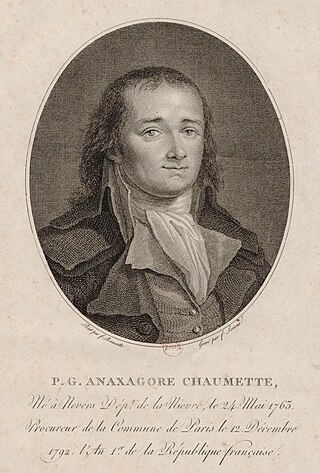
Pierre Gaspard Anaxagore Chaumette was a French politician of the Revolutionary period who served as the president of the Paris Commune and played a leading role in the establishment of the Reign of Terror. He was one of the ultra-radical enragés of the revolution, an ardent critic of Christianity who was one of the leaders of the dechristianization of France. His radical positions resulted in his alienation from Maximilien Robespierre, and he was arrested and executed.
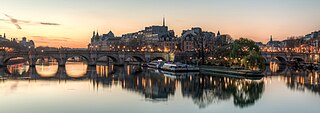
Île de la Cité is an island in the river Seine in the center of Paris. In the 4th century, it was the site of the fortress of the area governor for the Roman Empire. In 508, Clovis I, the first King of the Franks, established his palace on the island. In the 12th century, it became an important religious center, the home of Notre-Dame cathedral, and the royal chapel of Sainte-Chapelle, as well as the city hospital, the Hôtel-Dieu. It is also the site of the city's oldest surviving bridge, the Pont Neuf.
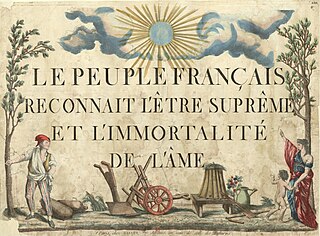
The Cult of the Supreme Being was a form of theocratic deism established by Maximilien Robespierre during the French Revolution as the intended state religion of France and a replacement for its rival, the Cult of Reason, and of Roman Catholicism. It went unsupported after the fall of Robespierre and, along with the Cult of Reason, was officially banned by First Consul Napoleon Bonaparte in 1802.

The Cult of Reason was France's first established state-sponsored atheistic religion, intended as a replacement for Roman Catholicism during the French Revolution. After holding sway for barely a year, in 1794 it was officially replaced by the rival deistic Cult of the Supreme Being, promoted by Robespierre. Both cults were officially banned in 1802 by Napoleon Bonaparte with his Law on Cults of 18 Germinal, Year X.
The aim of a number of separate policies conducted by various governments of France during the French Revolution ranged from the appropriation by the government of the great landed estates and the large amounts of money held by the Catholic Church to the termination of Christian religious practice and of the religion itself. There has been much scholarly debate over whether the movement was popularly motivated or motivated by a small group of revolutionary radicals. These policies, which ended with the Concordat of 1801, formed the basis of the later and less radical laïcité policies.
Atheism is the rejection of an assertion that a deity exists. In a narrower sense, hard atheism is specifically the position that there are no deities, effectively taking the stance of a positive claim in regards to the existence of any goddess or god. The English term 'atheist' was used at least as early as the sixteenth century and atheistic ideas and their influence have a longer history.

The Church of St. Eustache, Paris, is a church in the 1st arrondissement of Paris. The present building was built between 1532 and 1632.

The Church of Saint-Germain l'Auxerrois is a medieval Roman Catholic church in the 1st arrondissement of Paris, directly across from the Louvre Palace. It was named for Saint Germanus of Auxerre, a medieval bishop of Auxerre, who became a papal envoy and met Saint Genevieve, the patron saint of Paris, on his journeys. Genevieve is reputed to have converted queen Clotilde and her husband, French king Clovis I to Christianity at the tomb of Saint Germain in Auxerre.

Sylvain Maréchal was a French essayist, poet, philosopher and political theorist, whose views presaged utopian socialism and communism. His views on a future golden age are occasionally described as utopian anarchism. He was editor of the newspaper Révolutions de Paris.

Forcalquier Cathedral, now the Church of Notre-Dame-du-Bourguet, is a former Roman Catholic cathedral, and a national monument of France, located in the town of Forcalquier, Alpes-de-Haute-Provence.

The Musée de l'Œuvre Notre-Dame is the city of Strasbourg's museum for Upper Rhenish fine arts and decorative arts, dating from the early Middle Ages until 1681. The museum is famous for its collection of original sculptures, glass windows, architectural fragments, as well as the building plans of Strasbourg Cathedral. It has a considerable collection of works by Peter Hemmel von Andlau, Niclas Gerhaert van Leyden, Nikolaus Hagenauer, Ivo Strigel, Konrad Witz, Hans Baldung and Sebastian Stoskopff.

Irreligion in France has a long history and a large demographic constitution, with the advancement of atheism and the deprecation of theistic religion dating back as far as the French Revolution. In 2015, according to estimates, at least 29% of the country's population identifies as atheists and 63% identifies as non-religious.

The Church of Notre-Dame, Versailles, is a Roman Catholic parish church in Versailles, Yvelines, France, in the Rue de la Paroisse.

Notre-Dame-de-l'Assomption is a Roman Catholic church in the First arrondissement of Paris, France. The building was constructed between 1670 and 1676 when it was consecrated. Since 1844 it has been the main Polish church of Paris, situated at 263, Rue Saint-Honoré.

Pierre Desvignes was a French composer.
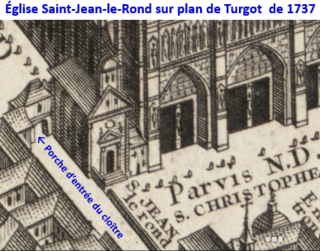
The Church of Saint-Jean-le-Rond, Paris was a small church originally attached to the north side of the Cathedral of Notre-Dame de Paris near the west front, and close to the entrance of the cloister. It was built earlier than Notre-Dame, at about the same time as the church which preceded Notre-Dame, the Cathedral of Saint-Etienne. It was dedicated to John the Baptist, and was used primarily as a baptistry. It survived centuries longer than the Cathedral of Saint Etienne, but was finally demolished in the early 18th century to make room for a new street, the rue du Cloître-Notre-Dame.

















